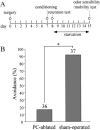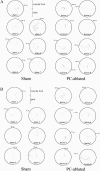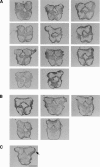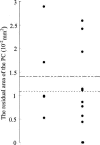The procerebrum is necessary for odor-aversion learning in the terrestrial slug Limax valentianus
- PMID: 16847307
- PMCID: PMC1538926
- DOI: 10.1101/lm.257606
The procerebrum is necessary for odor-aversion learning in the terrestrial slug Limax valentianus
Abstract
The terrestrial slug Limax has a highly developed ability to associate the odor of some foods (e.g., carrot juice) with aversive stimuli such as the bitter taste of quinidine solution. The procerebrum (PC) is a part of the slug's brain thought to be involved in odor-aversion learning, but direct evidence is still lacking. Here we present evidence showing that the PC is essential for odor-aversion learning. Unlike sham-operated slugs, PC ablation 7 d prior to conditioning showed that most slugs did not avoid carrot juice in the memory retention test conducted 24 h after the conditioning. Slugs with the PC ablated 3 h, 1 d, 3 d, or 7 d after conditioning and examined by the memory retention test at 3 d after the PC ablation were also less likely to avoid carrot juice than sham-operated slugs. The PC ablation did not damage the ability of the slugs to sense attractive odor (everyday food) or innately aversive odor (onion or garlic). These results demonstrate that the PC is a necessary component in the retention and/or retrieval of odor-aversion memory.
Figures






Similar articles
-
Recovery of learning ability after the ablation of the procerebrum in the terrestrial slug, Limax valentianus.Acta Biol Hung. 2008;59 Suppl:73-6. doi: 10.1556/ABiol.59.2008.Suppl.11. Acta Biol Hung. 2008. PMID: 18652375
-
Unilateral memory storage in the procerebrum of the terrestrial slug Limax.Neurobiol Learn Mem. 2010 Mar;93(3):337-42. doi: 10.1016/j.nlm.2009.11.008. Epub 2009 Nov 27. Neurobiol Learn Mem. 2010. PMID: 19945539
-
Reactivation-dependent changes in memory states in the terrestrial slug Limax flavus.Learn Mem. 1997 Nov-Dec;4(4):356-64. doi: 10.1101/lm.4.4.356. Learn Mem. 1997. PMID: 10706372
-
Oscillations and gaseous oxides in invertebrate olfaction.J Neurobiol. 1996 May;30(1):110-22. doi: 10.1002/(SICI)1097-4695(199605)30:1<110::AID-NEU10>3.0.CO;2-Q. J Neurobiol. 1996. PMID: 8727987 Review.
-
Taste and odor recognition memory: the emotional flavor of life.Rev Neurosci. 2012;23(5-6):481-99. doi: 10.1515/revneuro-2012-0064. Rev Neurosci. 2012. PMID: 23072843 Review.
Cited by
-
Changes in frequency of spontaneous oscillations in procerebrum correlate to behavioural choice in terrestrial snails.Front Cell Neurosci. 2009 Aug 27;3:8. doi: 10.3389/neuro.03.008.2009. eCollection 2009. Front Cell Neurosci. 2009. PMID: 19753329 Free PMC article.
-
Identification and classification of innexin gene transcripts in the central nervous system of the terrestrial slug Limax valentianus.PLoS One. 2021 Apr 15;16(4):e0244902. doi: 10.1371/journal.pone.0244902. eCollection 2021. PLoS One. 2021. PMID: 33857131 Free PMC article.
-
Do terrestrial gastropods use olfactory cues to locate and select food actively?Invert Neurosci. 2017 Sep;17(3):9. doi: 10.1007/s10158-017-0202-2. Epub 2017 Jul 8. Invert Neurosci. 2017. PMID: 28688004 Review.
-
RFamidergic neurons in the olfactory centers of the terrestrial slug Limax.Zoological Lett. 2018 Aug 9;4:22. doi: 10.1186/s40851-018-0108-9. eCollection 2018. Zoological Lett. 2018. PMID: 30116553 Free PMC article.
-
Spontaneous recovery of the injured higher olfactory center in the terrestrial slug limax.PLoS One. 2010 Feb 8;5(2):e9054. doi: 10.1371/journal.pone.0009054. PLoS One. 2010. PMID: 20161701 Free PMC article.
References
-
- Balaban P.M., Vehovszky A., Maksimova O.A., Zakharov I.S. Effect of 5,7-dihydroxytryptamine on the food-aversive conditioning in the snail Helix lucorum L. Brain Res. 1987;404:201–210. - PubMed
-
- Chase R., Tolloczko B. Interganglionic dendrites constitute an output pathway from the procerebrum of the snail Achatina fulica. J. Comp. Neurol. 1989;283:143–152. - PubMed
-
- Chase R., Tolloczko B. Tracing neural pathways in snail olfaction: From the tip of the tentacles to the brain and beyond. Microsc. Res. Tech. 1993;24:214–230. - PubMed
-
- Davis R.L. Olfactory learning. Neuron. 2004;44:31–48. - PubMed
Publication types
MeSH terms
LinkOut - more resources
Full Text Sources
Research Materials
